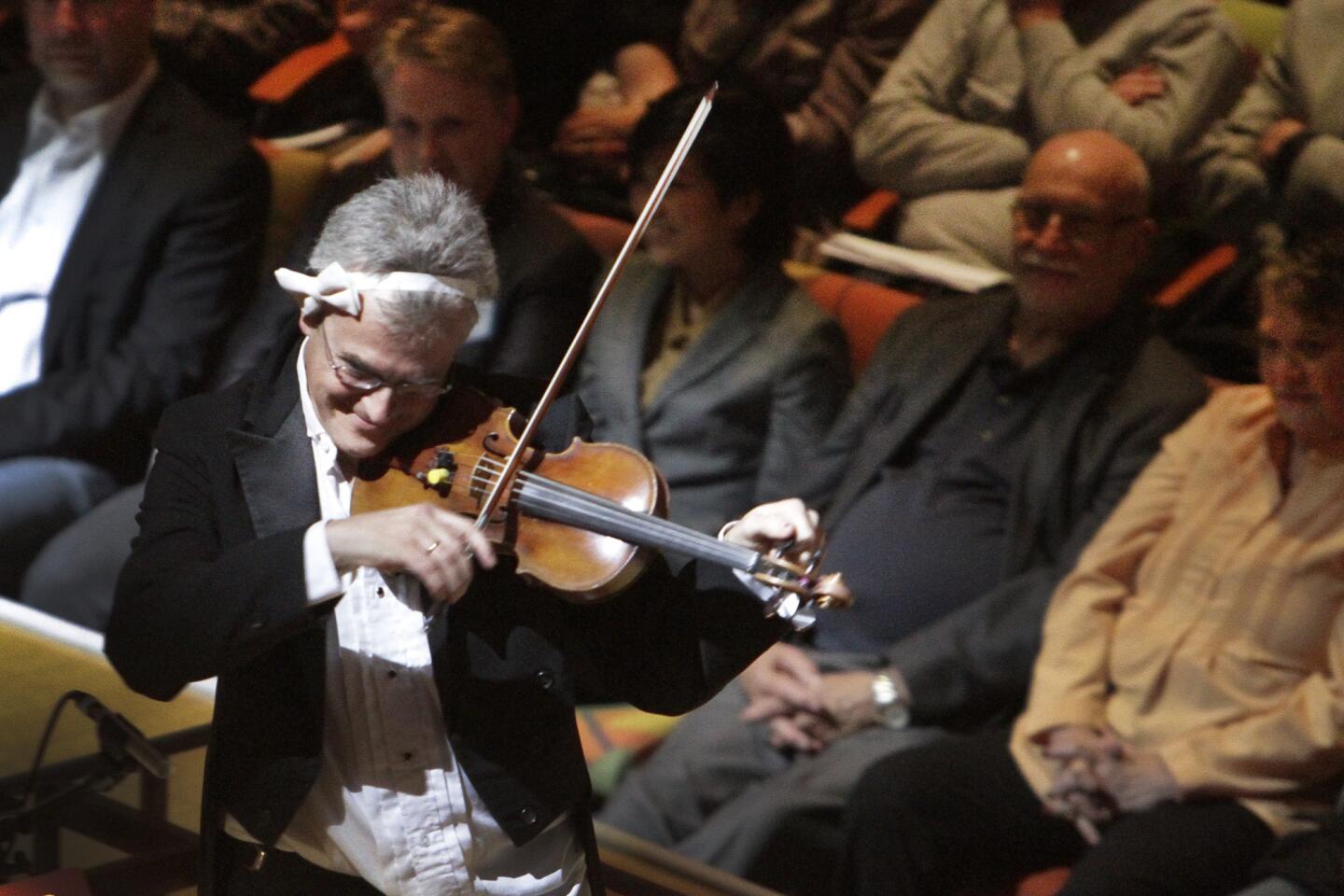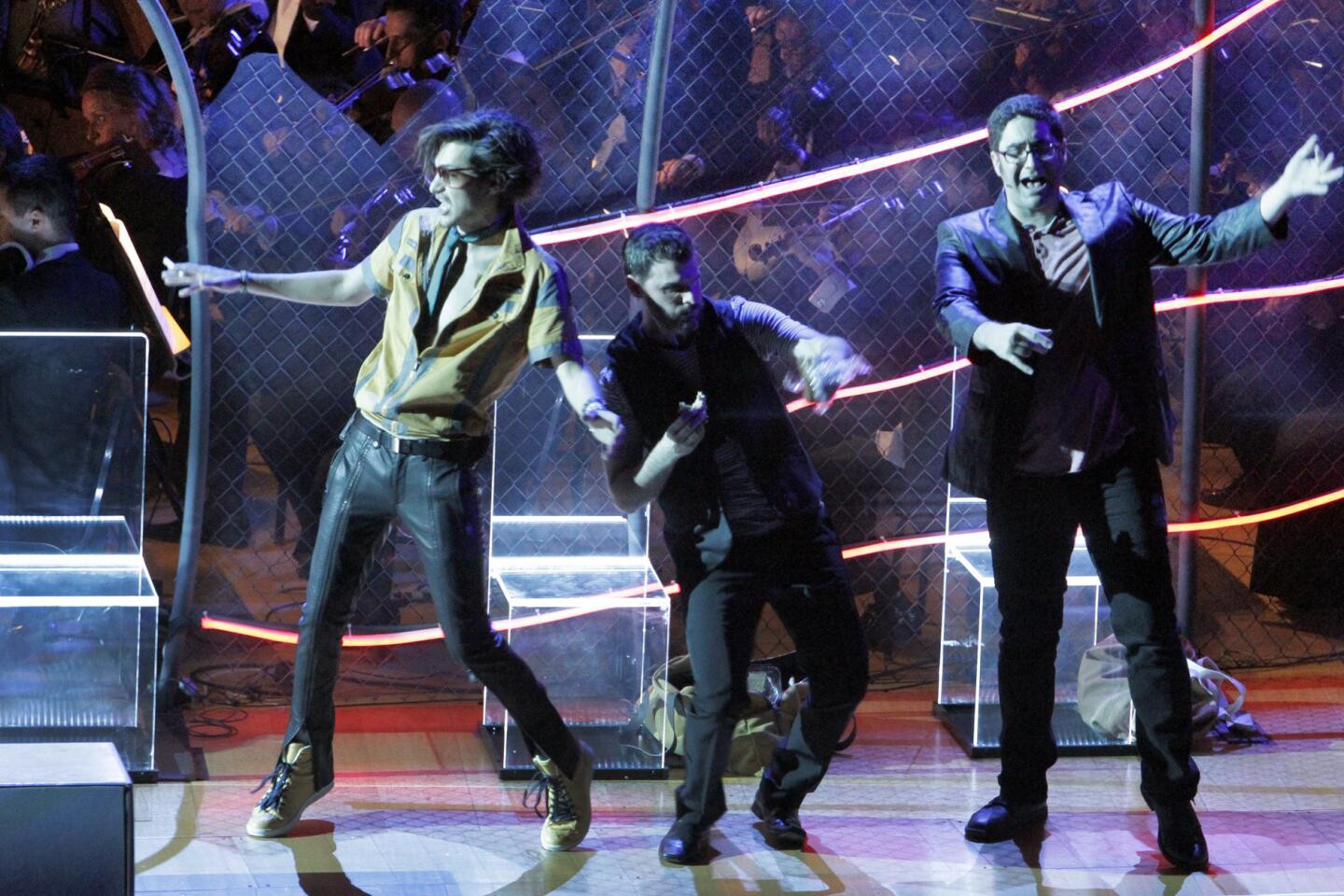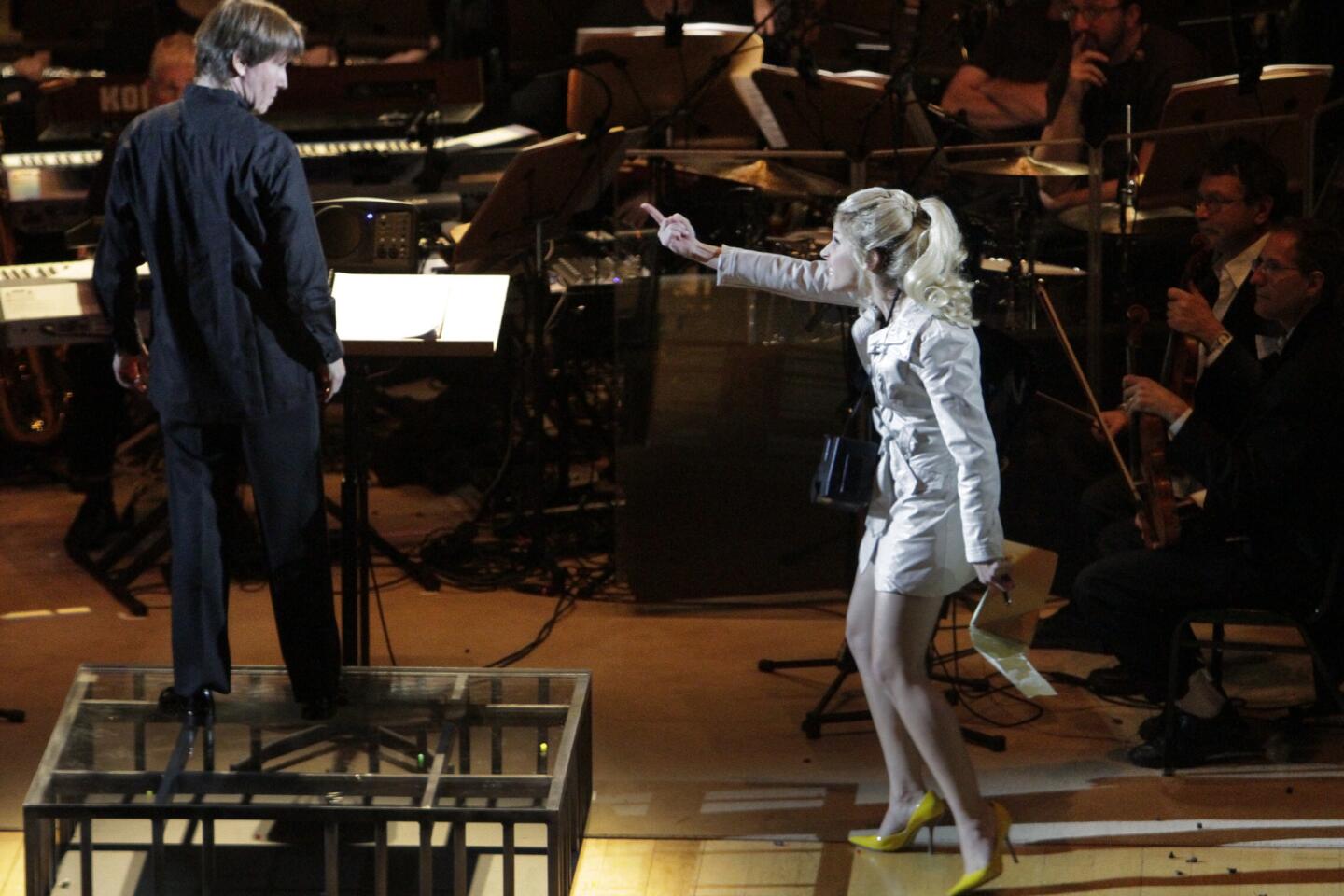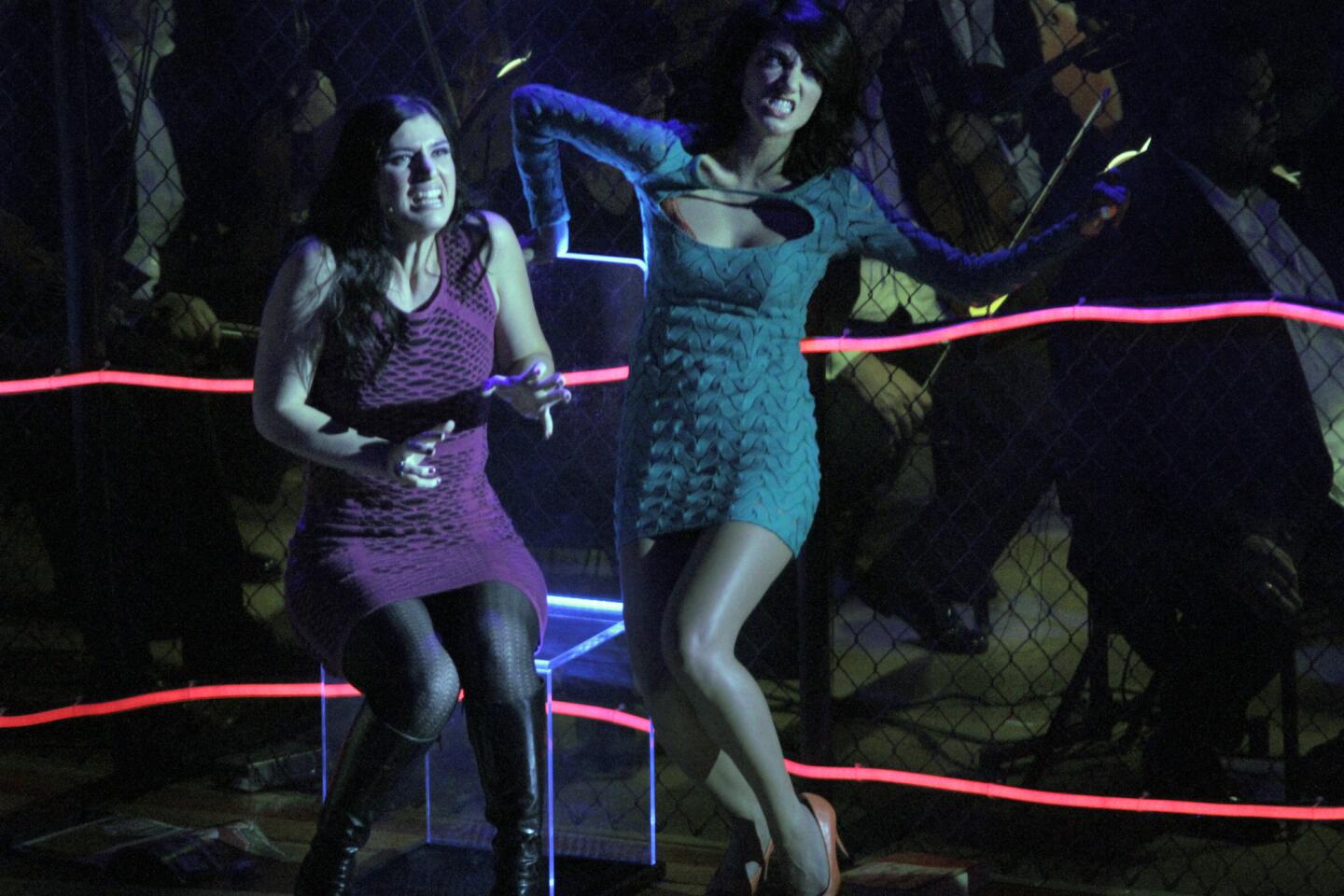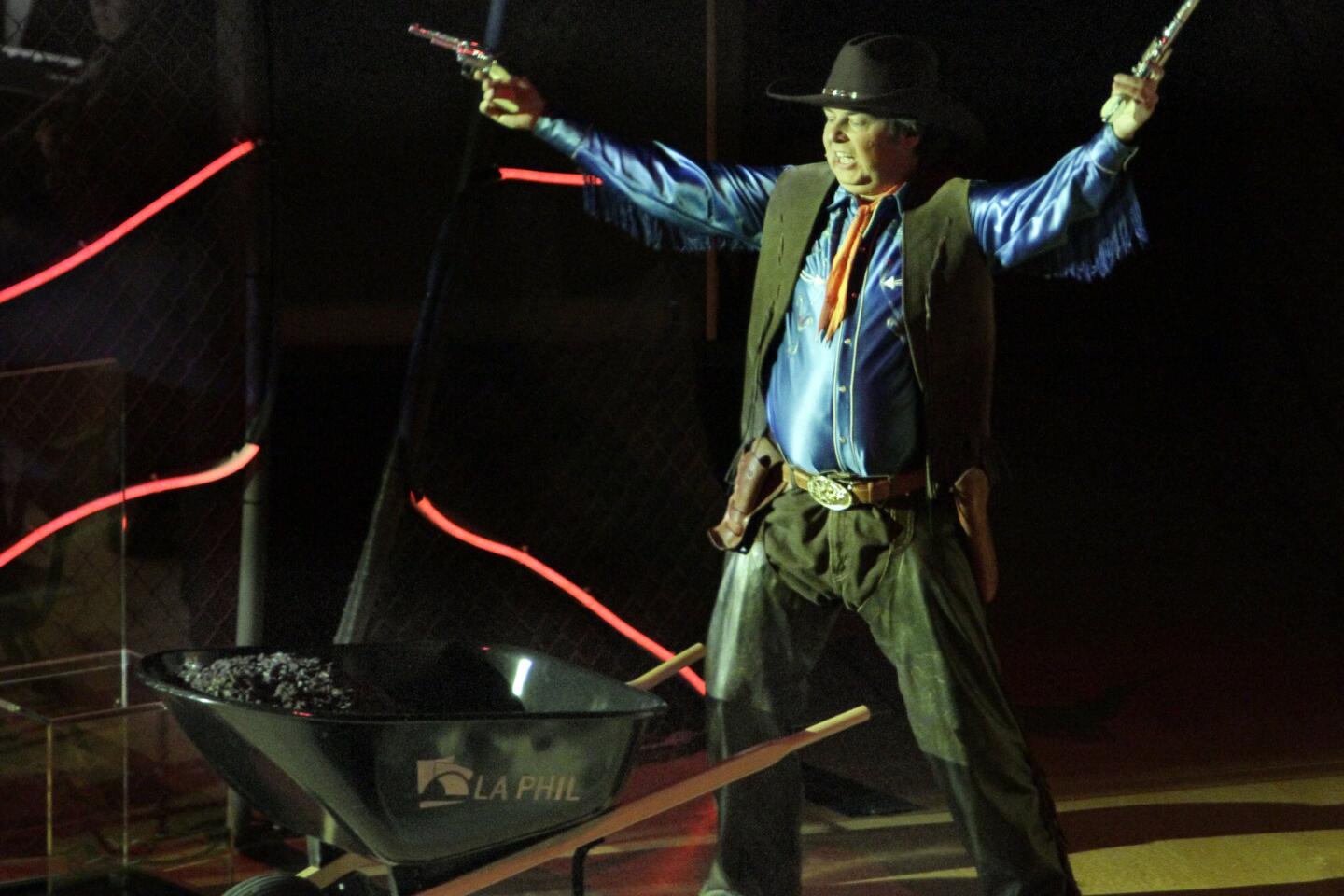Review: A safer stay in ‘200 Motels’
“Hit it, Zubin!”
Thus spake Zappa in Pauley Pavilion in 1970. Forty-three years later, this immortal injunction to Zubin Mehta at the premiere of Frank Zappa’s “200 Motels” came back Wednesday night to haunt us. And taunt us. We think of the Los Angeles Philharmonic, once it moved into Walt Disney Concert Hall, as having become a uniquely relevant and risk-taking orchestra. After all, it celebrated the 10th anniversary of the opening of the hall on Wednesday with a staged production of the world premiere of what is being called Zappa’s “200 Motels — The Suites.” The audience had been warned that the performance contained mature content and language.
But none of this could have happened without a little experience in orchestral weirdness.
On May 15, 1970, Zappa and his Mothers of Invention joined the L.A. Phil on UCLA’s basketball court for the highlight of a new music festival called Contempo ’70. Advertisements promised an entire string section producing “bodily-function noises.” The crowd numbered 14,500 and included a great many hippies with an agenda of their own. Zappa managed to insult, or at least parody, just about everyone in sight. Technical glitches were a nightmare. Mehta, who conducted, appeared uptight.
Martin Bernheimer, in these pages, called it an unsettling evening.
CRITICS’ PICKS: What to watch, where to go, what to eat
Those were the days. Wednesday evening proved far sillier than unsettling. An amiable mix of now-grown-up hippies, young people, classical music curiosity-seekers (including management types from the East Coast), the usual new music crowd and hard-core Zappa-istas roared their approval.
Esa-Pekka Salonen — who led a large L.A Phil enhanced with rock musicians and the Los Angeles Master Chorale — was cheered like a rock star. The orchestra looked to be having a ball. The so-called illuminated sex toys that the chorus held up near the evening’s end looked from a distance like stylized candles.
Zappa’s “200 Motels” is more an idea than an actual piece. What the L.A. Phil played in 1970 was a handful of numbers for the Mothers and/or the orchestra that Zappa, then 29, had been working on for several years in motels while he and his band were on tour.
This was drawn from what Zappa had imagined would be a huge but impractical piece. A 90-minute central section for very large orchestra and chorus was not included at the Pauley, where instead there were pieces by Varèse and Stravinsky. The electronics failed in a piece by Mel Powell for orchestra and tape, and the CalArts composer left in a huff before it could be retried. A year later, Zappa used some bits from the Pauley Pavilion show and other bits as the basis for a bizarre and occasionally brilliant film he shot in England that featured Ringo Starr as Zappa alter-ego Larry the Dwarf, placed the Royal Philharmonic in a concentration camp (to show what Zappa thought of symphony orchestras) and presaged rock videos by a decade.
PHOTOS: Arts and culture in pictures by The Times
Basically, “200 Motels” is a mess of material by a young composer with little orchestral experience. The 13 suites culled from Zappa’s papers that make up the new version last around 100 minutes, still nearly an hour shorter than the original piece. More significantly, there is no longer the huge presence of Zappa, who died two decades ago, and now the rock musicians are more closely integrated into the orchestra.
For the Disney Hall performance, director James Darrah came up with a staging concept that included the main characters and bits of dialogue from the film — Larry (Jeff Taylor), Rance (Michael Des Barres), Mark (Matt Marks), Howard (Zach Villa) and Cowboy Burt (Rich Fulcher), along with a few others, including Zappa’s daughter Diva. These are essentially comic book rock characters acting out on the road and commenting on the sorry state of plastic Middle America.
Parts of the dialogue were timely and thus clearly new. The amplification was poor and much was hard to understand. Some of the sung texts were projected. Some weren’t. A little raunchiness came through, but it was toned down and real offense was avoided like the plague. But four members of the orchestra reportedly objected and were excused.
A large team was responsible for fanciful sets, costumes, lighting and projections, and cute they were. Skinny Zappa look-alikes clowned around.
But if the real Zappa raised puerility to an art form, he was at least funny and knew how to hit the targets of his satire. Even an allusion to the L.A. Phil being imprisoned had little edge, not with concertmaster Martin Chalifour wearing a bow tie in his hair and other players in various states of goofy formalwear disarray.
CHEAT SHEET: Fall arts preview
Musically, the performance had some terrific moments, although amplification of the musicians and singers seemed crude, failing to offer the extraordinary sense of instrumental and vocal textures that characterized Zappa’s music.
Zappa was as much an enabler as he was a composer. He threw in the kitchen sink, alternating high European Modernism with ‘50s doo-wop and R&B at a time when such contrasts were truly outrageous. Here things blended almost comfortably. Thanks to Zappa’s inexperience and irrepressible preposterousness, he massively overwrote for the orchestra. But Salonen had a laser-like focus on what was interesting and the L.A. Phil nailed the score spectacularly.
And finally, there was Hila Plitmann as the sexy soprano soloist. Zappa originally wanted the new music star Cathy Berberian. Plitmann cavorted in high heels and short skirt while singing in high, crazy flourishes. Her opposite was the bass Morris Robinson, who was a hoot.
The Finale was “Strictly Genteel,” a feel-good parody with which Zappa regularly ended the Mothers’ sets. Here, it was much more feel-good than parody, Salonen even letting out a little of his inner ABBA. It sounded simply glorious, and we can only wonder what Zappa have thought of that.
The performance was recorded for audio release (fortunately, there will be no video). If the mixing is done with the care that Zappa also brought to his studio work and the dopey dialogue excised, this will be the best way to hear the score – and all but assure a hit.
More to Read
The biggest entertainment stories
Get our big stories about Hollywood, film, television, music, arts, culture and more right in your inbox as soon as they publish.
You may occasionally receive promotional content from the Los Angeles Times.

